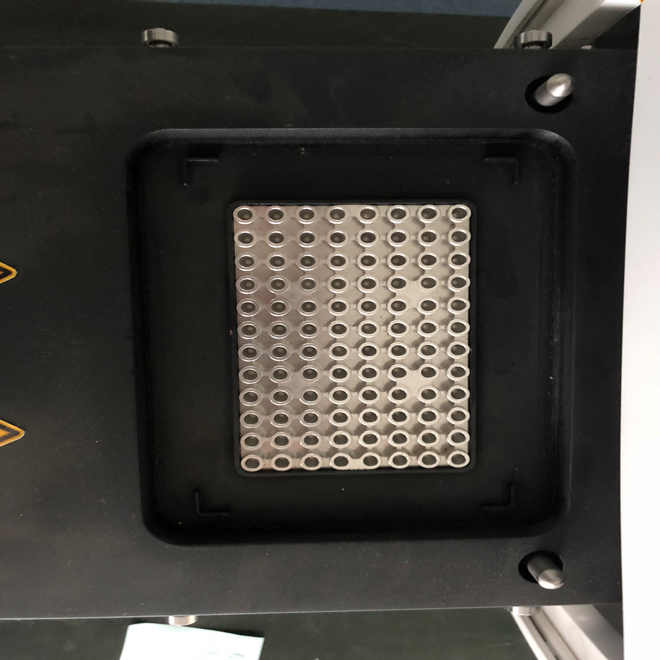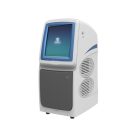Description
Quick Details
Sample capacity(wells): 96
Reaction Volume:0-100 μL
Consumables:0.2ml 96-well Plates??unskirt??; 0.2ml 8-strip tubes ,0.2ml PCR single tube(Optical flat cap,clear??frosted??white tube)
Temperature range :0°C-100°C
Heating/cooling method: Peltier
Max heating rate :6.1°C/sec
Average heating rate :4.5°C/sec
Max cooling rate :5.0°C/sec
Average cooling rate :2.8°C/sec
Temperature accuracy :±0.1??
Temperature uniformity :±0.1??
Real-Time PCR System MSLPCR15E | Medsinglong qpcr machine
Packaging & Delivery
| Packaging detail:Standard export package Delivery detail:within 7-10 workdays after receipt of payment |
Specifications
Real-Time PCR System MSLPCR15E | Medsinglong qpcr machine Features:
Sample capacity(wells): 96
Reaction Volume:0-100 μL
Consumables:0.2ml 96-well Plates??unskirt??; 0.2ml 8-strip tubes ,0.2ml PCR single tube(Optical flat cap,clear??frosted??white tube)
Temperature range :0°C-100°C
Heating/cooling method: Peltier
Max heating rate :6.1°C/sec
Average heating rate :4.5°C/sec
Max cooling rate :5.0°C/sec
Average cooling rate :2.8°C/sec
Temperature accuracy :±0.1??
Temperature uniformity :±0.1??

Gradient Range:1°C-40°C
Gradient block:12 row
Special temperature portocol:Gradient PCR,Long PCR,Touch Down PCR
Temperature range: Room Temperature–110°C
Excitation Source:6 LEDs
Detector:Photodiode
Detection Position:Excitation and scan at top
Detection method:6 channels scanning at the same time, no edge effect.
Detection time:7 seconds for 96 wells for all channels
Range of
Real-Time PCR System MSLPCR15E | Medsinglong qpcr machine excitation/
emission wavelengths
(nm):
1 465 /510 (FAM,SYBR Green I??SYTO9??EvaGreen??LC Green)
2 527/ 563 (HEX,VIC,TET,JOE)
3 580 /616 (ROX,Texas Red)
4 632/ 664( Cy5)
5 680 /730 (Alexa Fluor680)
6 465 /616 (FRET)

Probe:Taqman Probe,Molecular beacons probe,Scorpion probe ,FRET
Multiplexing:Up to 6 targets
Fluorescence Linearity :r≥0.990
Fluorescence Dynamic Range:Adjustable
Real-Time PCR System MSLPCR15E | Medsinglong qpcr machine

Data Analysis modes:
Qualitative analysis,Absolute quantification,Relative,quantification,Genotyping analysis,Endpoint analysis,Melt curve analysis, High Resolution Melting
Control modes:
1.10.4' touch screen
2. PC direct control
3. WLAN control(One PC can control max 10 units, and device can be controled by any PC in the WLAN)
Sample Drawer:Touch sreen commend
Data Stroage:Upload and download through USB disk,1000 results can be stored in machine
Power failure protection:Automaticly start running experiments after power supply, no need wait PC software
Customize Report:Templetes reserved ,report can customized
Administration Management:Administrator can set funtions limts for users
Transport Locker:Automaticly detect transport locker
Fault Management:Fault report and analysis, solution instruction
LIS connection:CSV,Excel,TXT format data output,open port for LIS connection

PC operating system:Win 7, Win 10
Communication Port: 1 ethernet and 3 USB
Footprint(WxDxH):355mm X 480mm X 485mm
Weight :30kg
Power usage:AC 100 to 125 V / 200 to 240 V (50/60 Hz).
power consumption:900VA
Work environment:Tempereture:10°C~30°C Humidity:20%~85%

Which real-time or digital PCR system is right for you?
To understand why traditional PCR is limited, it is important to understand what happens during the PCR reaction. A basic PCR run can be divided into three phases:
Index period
Accumulated product exactly doubles with each cycle (assuming 100% reaction efficiency). The reaction is highly specific and precise. Exponential amplification occurs because all reagents are freshly available and the kinetics of the reaction drive the reaction in favor of amplicon doubling.
Linear phase (high variability)
As the reaction continues, some reagents are consumed by amplification. The reaction starts to slow down, and the PCR product no longer doubles with each cycle.
Real-Time PCR System MSLPCR15E | Medsinglong qpcr machine
Plateau (endpoint: gel detection using conventional methods)
The reaction stops, no more product is produced, and if left long enough, the PCR product will start to degrade. Because each sample has different reaction kinetics, each tube or reaction will plateau at a different time point. These differences can be seen during the plateau. During the plateau period, conventional PCR performs the measurement, also known as endpoint detection.
Variation in plateau measurements with conventional PCR
Three replicate samples had the same amount of DNA at the start of the reaction and different amounts of PCR product during the plateau phase of the reaction (due to changes in reaction kinetics). Therefore, it will be more accurate to make measurements during the exponential period, where replicate samples expand exponentially.
Real-time PCR measures during exponential phase for more accurate quantitation
Real-time PCR focuses on the exponential phase because it provides more precise data for quantification. During the exponential period, the real-time PCR instrument calculates two values. The threshold line is the level of detection at which the fluorescence intensity of the reaction exceeds background. The PCR cycle at which the sample reaches this level is called the cycle threshold (Ct). Ct values are used for downstream quantification or presence/absence detection. By comparing the Ct values of a sample of unknown concentration with a series of standards, the amount of template DNA in an unknown reaction can be accurately determined.
Digital PCR counts individual molecules for absolute quantification
Digital PCR works by splitting the sample into many individual real-time PCR reactions; some of these reactions contain the molecule of interest (positive) and others do not (negative). After PCR analysis, a fraction of the negative results are used to generate absolute results for the exact amount of target molecule in the sample without the need for reference standards or endogenous controls.
MedsinglongPCR system, from kits, instruments, enzymes, master mixes, reagents, optical cartridges, plastic accessories, spare parts to software etc. Medsinglong real-time quantitative PCR system is a fully integrated quantitative PCR amplification, detection and data analysis system. Medsinglong increases productivity with its unique modular and flexible design, intuitive touch screen interface, advanced and easy-to-use reporting system, and monitors more than 120 attributes through built-in online diagnostic system, so that when analytical problems or instrument problems arise find out the reason.















There are no reviews yet.